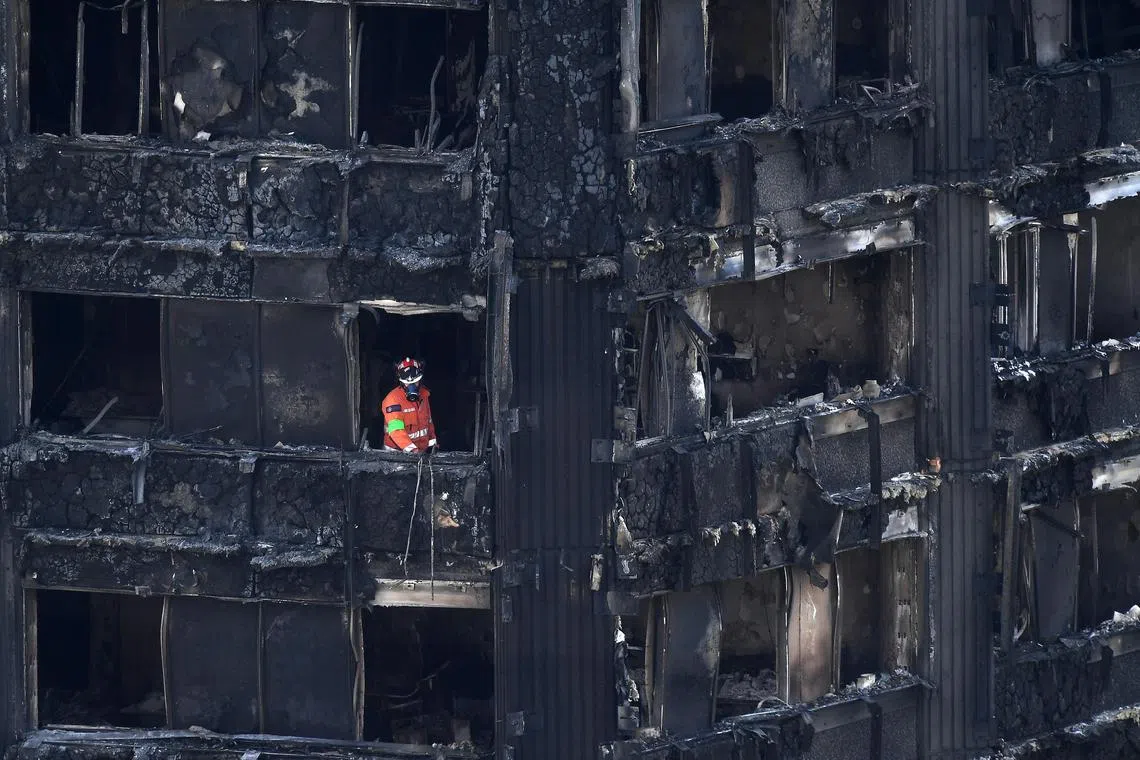Grenfell Tower fire inquiry blames deaths on incompetence and greed
Sign up now: Get ST's newsletters delivered to your inbox

A total of 72 people died when fire ripped through a 23-storey social housing block in the early hours of June 14, 2017.
PHOTO: EPA-EFE
Follow topic:
LONDON – A public inquiry into the devastating 2017 London Grenfell Tower blaze
The fire ripped through the 23-storey social housing block
“The simple truth is that the deaths that occurred were all avoidable,” inquiry chairman Martin Moore-Bick said.
In its long-awaited final report published on Sept 4, the inquiry laid most responsibility for the disaster on the companies involved in the maintenance and refit of the apartment tower, as well as companies that it said had dishonestly marketed combustible cladding materials as safe.
It also criticised the then government, the local authority of Kensington and Chelsea, the industry, regulatory groups, specific individuals and an ill-prepared fire brigade for years of inaction over fire safety in high-rise blocks.
“Not all of them bear the same degree of responsibility for the eventual disaster, but as our reports show, all contributed to it in one way or another, in most cases, through incompetence, but in some cases, through dishonesty and greed,” Mr Moore-Bick said.
The inquiry report, which ran to almost 1,700 pages, said the inferno was the culmination of “decades of failure”, with profits put before people.
“The duty of government should be to safeguard life, whilst protecting us from corporate greed,” said Grenfell United, a group representing some survivors and bereaved families.
“But for too long, they have aided corporations, facilitating them to profit and dictate regulation.”
Prime Minister Keir Starmer apologised to the relatives of victims and survivors on behalf of the British state, saying they had been failed for years.
“It should never have happened. The country failed to discharge its most fundamental duty, to protect you and your loved ones,” he said in Parliament, where some bereaved relatives watched on.
“Today is a long-awaited day of truth, but it must now lead to a day of justice.”
The British police have said 58 people and 19 firms and organisations are under investigation. But any prosecutions – including for corporate manslaughter and fraud – remain years away because of the complexity and need to consider the inquiry’s report.
“It (the inquiry) has delayed the justice my family deserves,” said 46-year-old Hisam Choucair, who lost his mother, sister, brother-in-law and three young nieces in the fire.
Fridge fire
An earlier report by the inquiry team in 2019, which focused on the events of the night, found that an electrical fault in a refrigerator
Flames then spread uncontrollably, mainly because the tower had been covered during a 2016 refurbishment with cladding – exterior panels designed to improve appearance and add insulation – made of flammable aluminium composite material that acted as a source of fuel.
The harrowing accounts, including from those who died while awaiting rescuers and having followed official guidance to stay put, prompted fury and national soul-searching over building standards and the treatment of low-income communities.
The inquiry, headed by retired judge Moore-Bick, found a litany of failings, saying lessons had not been learnt from past high-rise tower blazes and testing systems were inadequate.
The most overt blame was laid at the feet of those involved in the refurbishment of the tower with the flammable cladding.
The inquiry said architect Studio E, principal contractor Rydon and cladding sub-contractor Harley all bore considerable responsibility for the disaster.
Fire safety inspectors Exova were also blamed for the building being left “in a dangerous condition on completion of the refurbishment”.
Both Kensington and Chelsea council and the Tenant Management Organisation (TMO), which managed the local authority’s housing stock, were also heavily criticised.
The inquiry said they had shown indifference to fire safety regulations in the years before the blaze and that the TMO, whose difficult relationship with some residents was said to have created a “toxic atmosphere”, had been unduly focused on cutting costs.
While the local community and voluntary groups were praised for providing support, the council was also criticised for its slow, muddled and “wholly inadequate” response to the incident. The council’s leader said it accepted the findings and apologised.
There was also condemnation of those firms that made and sold the cladding or its foam insulation – Celotex, Kingspan, and Arconic Architectural Products, the French subsidiary of US company Arconic. The inquiry concluded there had been “systematic dishonesty” on their part.
“They engaged in deliberate and sustained strategies to manipulate the testing processes, misrepresent tested data and mislead the market,” the report said.
Arconic said it rejected any claim it had sold an unsafe product or tried to conceal information about tests of its materials.
Kingspan said it had “long acknowledged the wholly unacceptable historical failings” but said these were not causative of the tragedy.
The issue of exterior cladding has raised concerns across Europe where there have been similar blazes in apartment blocks, such as in the Spanish city of Valencia in February, and in Italy in 2021.
In Britain, government figures from July showed 3,280 buildings standing at 11m or higher still had unsafe cladding, with remediation work yet to start on more than two-thirds of them. REUTERS

